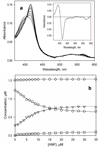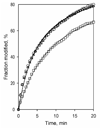Mechanism of interactions of alpha-naphthoflavone with cytochrome P450 3A4 explored with an engineered enzyme bearing a fluorescent probe
- PMID: 17198380
- PMCID: PMC2574515
- DOI: 10.1021/bi061944p
Mechanism of interactions of alpha-naphthoflavone with cytochrome P450 3A4 explored with an engineered enzyme bearing a fluorescent probe
Abstract
Design of a partially cysteine-depleted C98S/C239S/C377S/C468A cytochrome P450 3A4 mutant designated CYP3A4(C58,C64) allowed site-directed incorporation of thiol-reactive fluorescent probes into alpha-helix A. The site of modification was identified as Cys-64 with the help of CYP3A4(C58) and CYP3A4(C64), each bearing only one accessible cysteine. Changes in the fluorescence of CYP3A4(C58,C64) labeled with 6-(bromoacetyl)-2-(dimethylamino)naphthalene (BADAN), 7-(diethylamino)-3-(4'-maleimidylphenyl)-4-methylcoumarin (CPM), or monobromobimane (mBBr) were used to study the interactions with bromocriptine (BCT), 1-pyrenebutanol (1-PB), testosterone (TST), and alpha-naphthoflavone (ANF). Of these substrates only ANF has a specific effect, causing a considerable decrease in fluorescence intensity of BADAN and CPM and increasing the fluorescence of mBBr. This ANF-binding event in the case of the BADAN-modified enzyme is characterized by an S50 of 18.2 +/- 0.7, compared with the value of 2.2 +/- 0.3 for the ANF-induced spin transition, thus revealing an additional low-affinity binding site. Studies of the effect of TST, 1-PB, and BCT on the interactions of ANF monitored by changes in fluorescence of CYP3A4(C58,C64)-BADAN or by the ANF-induced spin transition revealed no competition by these substrates. Investigation of the kinetics of fluorescence increase upon H2O2-dependent heme depletion suggests that labeled CYP3A4(C58,C64) is represented by two conformers, one of which has the fluorescence of the BADAN and CPM labels completely quenched, presumably by photoinduced electron transfer from the neighboring Trp-72 and/or Tyr-68 residues. The binding of ANF to the newly discovered binding site appears to affect the interactions of the label with the above residue(s), thus modulating the fraction of the fluorescent conformer.
Figures











Similar articles
-
Energetics of heterotropic cooperativity between alpha-naphthoflavone and testosterone binding to CYP3A4.Arch Biochem Biophys. 2007 Jul 1;463(1):89-101. doi: 10.1016/j.abb.2007.03.006. Epub 2007 Apr 2. Arch Biochem Biophys. 2007. PMID: 17459328 Free PMC article.
-
Effect of glutathione on homo- and heterotropic cooperativity in cytochrome P450 3A4.Arch Biochem Biophys. 2008 Mar 15;471(2):134-45. doi: 10.1016/j.abb.2008.01.001. Epub 2008 Jan 11. Arch Biochem Biophys. 2008. PMID: 18206979 Free PMC article.
-
Kinetics of electron transfer in the complex of cytochrome P450 3A4 with the flavin domain of cytochrome P450BM-3 as evidence of functional heterogeneity of the heme protein.Arch Biochem Biophys. 2008 Mar 1;471(1):20-31. doi: 10.1016/j.abb.2007.11.020. Epub 2007 Dec 7. Arch Biochem Biophys. 2008. PMID: 18086551 Free PMC article.
-
Analysis of heterotropic cooperativity in cytochrome P450 3A4 using alpha-naphthoflavone and testosterone.J Biol Chem. 2011 Feb 18;286(7):5540-5. doi: 10.1074/jbc.M110.182055. Epub 2010 Dec 22. J Biol Chem. 2011. PMID: 21177853 Free PMC article.
-
Structures of cytochrome P450 3A4.Trends Biochem Sci. 2005 Jan;30(1):5-7. doi: 10.1016/j.tibs.2004.11.004. Trends Biochem Sci. 2005. PMID: 15653318 Review.
Cited by
-
Structures of cytochrome P450 2B4 complexed with the antiplatelet drugs ticlopidine and clopidogrel.Biochemistry. 2010 Oct 12;49(40):8709-20. doi: 10.1021/bi100914z. Epub 2010 Sep 15. Biochemistry. 2010. PMID: 20815363 Free PMC article.
-
NMR-derived models of amidopyrine and its metabolites in complexes with rabbit cytochrome P450 2B4 reveal a structural mechanism of sequential N-dealkylation.Biochemistry. 2011 Mar 29;50(12):2123-34. doi: 10.1021/bi101797v. Epub 2011 Mar 4. Biochemistry. 2011. PMID: 21375273 Free PMC article.
-
Nanodiscs in Membrane Biochemistry and Biophysics.Chem Rev. 2017 Mar 22;117(6):4669-4713. doi: 10.1021/acs.chemrev.6b00690. Epub 2017 Feb 8. Chem Rev. 2017. PMID: 28177242 Free PMC article. Review.
-
7,8-benzoflavone binding to human cytochrome P450 3A4 reveals complex fluorescence quenching, suggesting binding at multiple protein sites.J Biomol Struct Dyn. 2018 Mar;36(4):841-860. doi: 10.1080/07391102.2017.1301270. Epub 2017 Mar 20. J Biomol Struct Dyn. 2018. PMID: 28278026 Free PMC article.
-
Energetics of heterotropic cooperativity between alpha-naphthoflavone and testosterone binding to CYP3A4.Arch Biochem Biophys. 2007 Jul 1;463(1):89-101. doi: 10.1016/j.abb.2007.03.006. Epub 2007 Apr 2. Arch Biochem Biophys. 2007. PMID: 17459328 Free PMC article.
References
-
- Atkins WM. Non-Michaelis-Menten kinetics in cytochrome P450-catalyzed reactions. Annu. Rev. Pharmacol. Toxicol. 2005;45:291–310. - PubMed
-
- Atkins WM. Implications of the allosteric kinetics of cytochrome P450s. Drug Discovery Today. 2004;9:478–484. - PubMed
-
- Yoon MY, Campbell AP, Atkins WM. "Allosterism" in the elementary steps of the cytochrome P450 reaction cycle. Drug Metab. Rev. 2004;36:219–230. - PubMed
-
- Ekins S, Stresser DM, Williams JA. In vitro and pharmacophore insights into CYP3A enzymes. Trends Pharm. Sci. 2003;24:161–166. - PubMed
-
- Khan KK, Liu H, Halpert JR. Homotropic versus heterotopic cooperativity of cytochrome P450eryF: A substrate oxidation and spectral titration study. Drug Metab. Disp. 2003;31:356–359. - PubMed
Publication types
MeSH terms
Substances
Grants and funding
LinkOut - more resources
Full Text Sources

